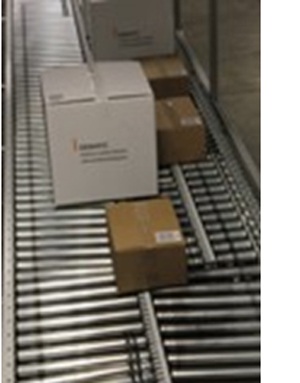Holste Says... |
 |
| Because order fulfillment processes are inherently complex and labor intensive, operations managers should examine all production areas from time-to-time to determine how they can be simplified and streamlined. |
 |
What do you say? |
 |
| Click here to send us your comments |
|
|
|
- Because order pickers can (and often do) pick next batch orders/cases ahead of the completion of the current batch, stragglers from the current batch can wind-up behind cases belonging to the new batch. Consequently, some of the shipping lanes will not be able to close out the current batch in a timely manner.
- System efficiency is degraded when cases belonging to the new batch of orders cannot be sorted and consequently start accumulating on the sorter recirculation loop. Left unattended, the recirculation loop will quickly become overloaded. When this happens, inbound case flow to the sorter is automatically shutdown causing those inbound conveyor lines to backup, which in-turn shuts down picking operations.
The congestion caused by the above picking scenario will quickly fill up the available accumulation. Adding more accumulation conveyor will delay the problem, but not fix it. A better approach would be to test different batch picking strategies such as, limiting the pickers to no more than two open batches at a time, and/or inserting end-of-batch totes in each picking zone before starting a new batch. The batch totes are then held at the central merge until the current batch is closed out.
An even better alternative would be to utilize the batch overlap function built into the WMS, which can optimize batch size and go a long way towards eliminating bottlenecks and gridlock. With batch overlap the shipping lanes are divided into two sections “A” & “B”. The WMS sorts the current batch cases into “A” shipping lanes. When the next batch is released for picking, those cases will be sorted into the “B” shipping lanes. In this way the shipping department associates can work on completing the current batch “A” while the next batch is being sorted and accumulated into the “B” lanes. This A/B back-and-forth will continue throughout the production cycle.
 In addition to picking strategies, shippers should also review critical path merge logic and conveyor/sorter speeds to determine if they can be adjusted for higher throughput capacity. In addition to picking strategies, shippers should also review critical path merge logic and conveyor/sorter speeds to determine if they can be adjusted for higher throughput capacity.
In that regard, most of the major system integrators offer carton singulator modules (pictured on left) that are designed to align skewed and “side-by-side” cartons for proper orientation prior to sorting. The singulator automatically corrects carton orientation and alignment. Thereby optimizing flow at merge points and the downstream sorter. This type of carton singulator can be retrofitted into existing systems.
Another good practice is to make sure that the right amount of labor is at the right place at the right time. This may seem elementary but can get out of sync quickly. For example: too many order pickers and not enough shipping personnel will cause system congestion that can reduce throughput and rob system efficiency and productivity. It is better to have a little excess capacity in shipping to insure that order fulfillment efficiency is maintained.
In the typical distribution system, the rate at which cases are introduced into the system from receiving, cross docking, picking, and staging areas, varies greatly throughout the production cycle. By analyzing each of these inbound production areas it is possible to estimate how much labor is required under various flow scenarios to keep all areas running at their target design rate. Sometimes computer simulations and or emulations can be effective tools for companies to use to better understand system performance, test picking and operational alternatives, identify potential bottlenecks, and understand the likely result of changes to an existing system.
Final Thoughts
Because order fulfillment processes are inherently complex and labor intensive, operations managers should examine all production areas from time-to-time to determine how they can be simplified and streamlined. Fine tuning slotting, order batching, pick path routing, and workflow paths, can yield productivity improvements with little or no capital expenditure.
Any reaction to this Expert Insight column? Send below.
Your Comments/Feedback
|